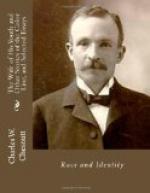There had been a little left. Mrs. Myrover was thrifty, and had laid by a few hundred dollars, which she kept in the house to meet unforeseen contingencies. There remained, too, their home, with an ample garden and a well-stocked orchard, besides a considerable tract of country land, partly cleared, but productive of very little revenue.
With their shrunken resources, Miss Myrover and her mother were able to hold up their heads without embarrassment for some years after the close of the war. But when things were adjusted to the changed conditions, and the stream of life began to flow more vigorously in the new channels, they saw themselves in danger of dropping behind, unless in some way they could add to their meagre income. Miss Myrover looked over the field of employment, never very wide for women in the South, and found it occupied. The only available position she could be supposed prepared to fill, and which she could take without distinct loss of caste, was that of a teacher, and there was no vacancy except in one of the colored schools. Even teaching was a doubtful experiment; it was not what she would have preferred, but it was the best that could be done. “I don’t like it, Mary,” said her mother. “It ’s a long step from owning such people to teaching them. What do they need with education? It will only make them unfit for work.”
“They ’re free now, mother, and perhaps they ’ll work better if they ’re taught something. Besides, it ’s only a business arrangement, and does n’t involve any closer contact than we have with our servants.”
“Well, I should say not!” sniffed the old lady. “Not one of them will ever dare to presume on your position to take any liberties with us. I ’ll see to that.”




